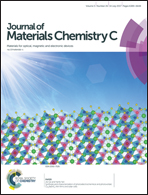Combined influence of plasmonic metal nanoparticles and dual cathode buffer layers for highly efficient rrP3HT:PCBM-based bulk heterojunction solar cells†
Abstract
The combined influence of plasmon-induced metallic nanoparticles (NPs), which increase the photoabsorption capability, and dual cathode buffer layers for enhanced charge collection is presented, which significantly improves the efficiency of organic photovoltaic (OPV) devices. Two different types of metal NPs, viz. citrate capped gold (Au) and silver (Ag) NPs, were blended (20 v/v%) separately into a PEDOT:PSS hole transport layer. For the dual cathode buffer layer, we chose two different hole blocking layers, BPhen and BCP, with a LiF/Al cathode contact. The combined influence of both the NPs and the dual cathode buffer layers was investigated with two blend polymers, rrP3HT:PC61BM and rrP3HT:PC71BM. It was observed that for both the blend polymer systems the power conversion efficiency (PCE) increases significantly in the presence of PEDOT:PSS + AuNPs and PEDOT:PSS + AgNPs with BCP/LiF/Al as a cathode contact compared to the bare PEDOT:PSS layer. In particular, in the presence of PEDOT:PSS + AuNPs and BCP/LiF/Al, the highest PCE was observed for both the blend polymers because of the better band alignment of BCP/LiF/Al with the active layers and the superior surface plasmon resonance of the AuNPs in the visible spectrum compared to AgNPs. The device with an ITO/PEDOT:PSS + AuNPs/rrP3HT:PC61BM/BCP/LiF/Al configuration showed a PCE (η) of 4.99% with Jsc = 13.9 mA cm−2, Voc = 0.59 V and FF = 62%, whereas for ITO/PEDOT:PSS + AuNPs/rrP3HT:PC71BM/BCP/LiF/Al, the device showed a PCE (η) of 5.65% with Jsc = 16.1 mA cm−2, Voc = 0.58 V and FF = 61%. These results conclusively explain the combined influence of the dual cathode buffer layer and the plasmonic metal NPs to remarkably improve the PCE and overall device performance of rrP3HT:PCBM based BHJ solar cells.



 Please wait while we load your content...
Please wait while we load your content...